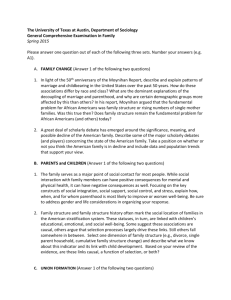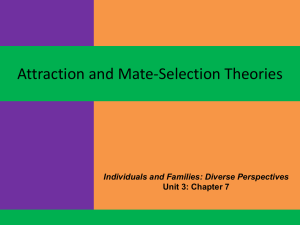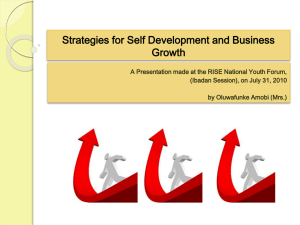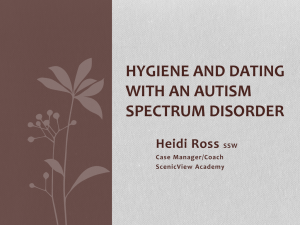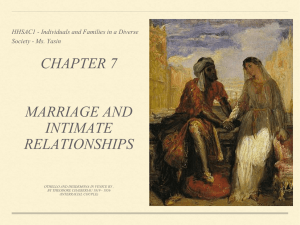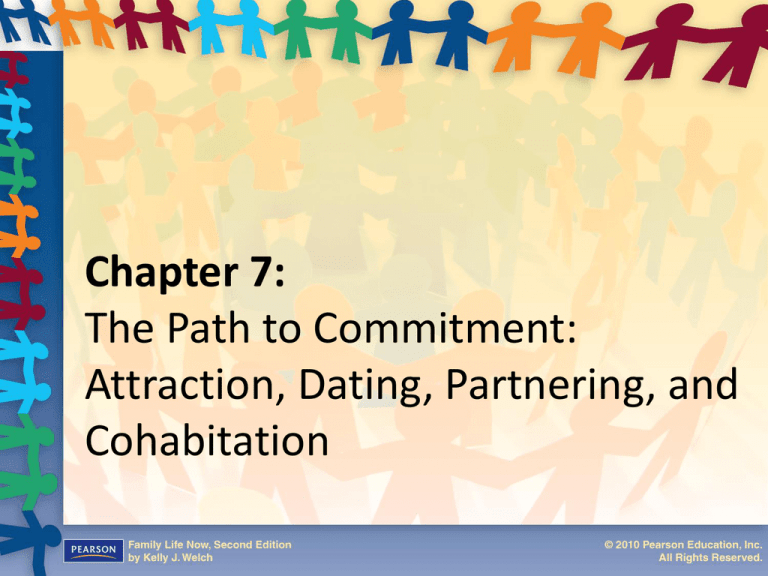
Chapter 7:
The Path to Commitment:
Attraction, Dating, Partnering, and
Cohabitation
Interpersonal Attraction
• The Evolutionary Theory
• Sexual selection
– Members of one sex compete among
themselves for opportunities to mate
• One person chooses to mate with a
specific person
• Some are more preferable than others
Interpersonal Attraction
• The Right Stuff: What Men Want
• Men are concerned with quantity according
to evolutionists
• Men select women who possess fertility cues
– Physical attractiveness
– Certain physiological features important
Interpersonal Attraction
• Reproductive Promise: Youth
– Youth equals attractiveness and
beauty
– Nip and tuck
• Surgical and non-surgical
procedures on women and men
increased dramatically
Interpersonal Attraction
• Reproductive Promise: The Language of
Curves
– Puberty signals changes in body shape for
males and females
– Waist-to-hip ratio contributes to
attractiveness
– Means woman is capable of reproducing
Interpersonal Attraction
• The Right Stuff: What Women Want
• Sexual selection – women more selective
than men
• Concerned with the quality of children
• Look for positive genetic traits and
characteristics
Interpersonal Attraction
• Provider/Protector Cues
• Women want man who:
– Can provide and protect
– Is willing to provide and protect
– Attraction based on protector/provider
cues
Interpersonal Attraction
• Women seek men who are culturally
successful
• Display dominant behaviors
• Ambition- determination and motivation
• Industry- hard work, diligence, productivity
• Good financial prospects- ability for
economic gain
Social Exchange Theory
• Key Concepts
– All behavior is a series of varying exchanges
– All individuals seek to maximize their
rewards and minimize their costs
– When rewards are received, the benefactor
feels obligated to reciprocate
– Rewards minus costs equal the outcome of
the interpersonal exchange
Figure 7.1: The
Filter Theory
of Mate
Selection
Filter Theory of Mate Selection
• Individuals use a filtering mechanism to sort out a
potential mate from the pool of candidates
• Filters
– Propinquity: geographic closeness
– Homogamy: someone who is similar to you
• Exogamy – outside a particular group
• Endogamy – inside a certain group
• Heterogamy – partners of different races
Filter Theory of Mate Selection
• Physical attractiveness filter – individuals are
attracted to those who are at least as
attractive as they are
• Balance sheet filter – refers to reciprocity
– look for someone who can offer us
something others cannot
Dating
• Purposes of dating
– Socialization: dating provides time for
interaction
– Recreation: provides time to enjoy each
other’s company and have fun
– Mate selection: provides opportunity to
compare and contrast personality traits of
different people
Table 7.1: Scripted
Events for a Typical
Date
Table 7.2: Scripts for Hypothetical and
Actual First Dates for Gay Men and
Lesbians
Dating in the
st
21
Century
• Speed dating - Allows people to meet each
other face to face and if they are interested,
then they can arrange for a more extended
date
• Internet Dating – internet chat rooms are
replacing bars as a meeting place for
available singles
Figure 7.3: Sexual Acts
in College Hookups
Dating in the
st
21
Century
• “Hookin’ up” – physical interactions without
absence or commitment or affection, gaining
popularity on college campuses
• “Friends with benefits” or “booty call” –
people who have regular sex but do not
relate as a couple
Figure 7.2: Dating–
Related Activities Online
Figure 7.3: Sexual Acts
in College Hookups
Knapp’s Relationship Escalation
Model
• Initiation – couples present their public
selves, observe the traits of the other person
• Experimenting/exploration – information
gathering stage
• Intensification – formal interactions give way
to less formal, more spontaneous
conversation
Knapp’s Relationship Escalation
Model
• Integrating – become a couple and are
identified as a couple
• Bonding/intimacy – couple reaches a shared
level of interdependence
Duck’s Relationship Filtering Model
• Sociological or incidental cue – a person’s
location or position
• Pre-interaction cue – at a glance information
helps to decide if they would want to date a
person
• Interaction cues – make assessments about
whether they want to get to know someone
better
Duck’s Relationship Filtering Model
• Cognitive cues – when we decide to spend
more time with someone, these cues tell us
more about a person than just superficial
information
Commitment
• Commitment is the result of 3 factors:
– Growing satisfaction with each other’s ability
to meet and gratify important needs
– Decreasing reliance on friends and family to
meet needs that the couple provides for each
other
– Increasing investments in the relationship
such as time, material resources and
emotional/personal investment
Commitment
A long term orientation
• 3 types of commitment:
– Personal commitment: feeling, thoughts,
beliefs about a life mate
– Moral commitment: a person’s value and
belief system
– Structural commitment: commitments
bound by institutions such as marriage
Table 7.3: Distress/Protest Reactions to
Breaking Up
Cohabitation
• The living arrangements of unmarried,
intimate partners
• Rates of cohabitation vary by
– Regions
– Religion
– Age
– Race
– Social class
– Educational attainment
Figure 7.4: Percentages of
Persons of the Opposite
Sex sharing Living
Quarters across regions
of the United States
Figure 7.5: Living
Together without
Getting Married
Figure 7.6: Rates
of Cohabitation
by Race
Figure 7.7: Percentage
of Parents Who were
Married or
Cohabitating at the
Birth of Their First
Child, by
Race/Ethnicity and
Sex
Does Cohabitation Work?
• Relationship dissatisfaction and marital
failure – cohabitation before marriage
correlated with high relationship
dissatisfaction and higher risk of divorce
• Relationship Violence – cohabitation before
marriage has an increased risk of violence
against women and children

